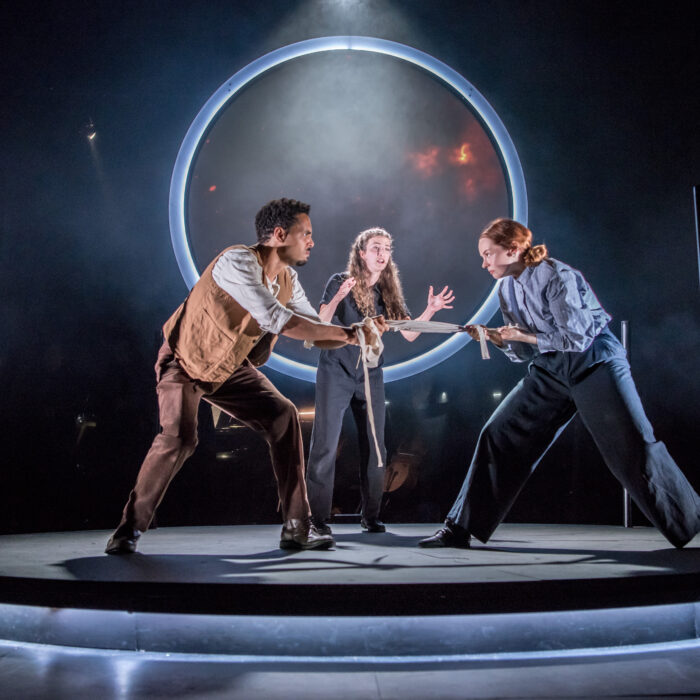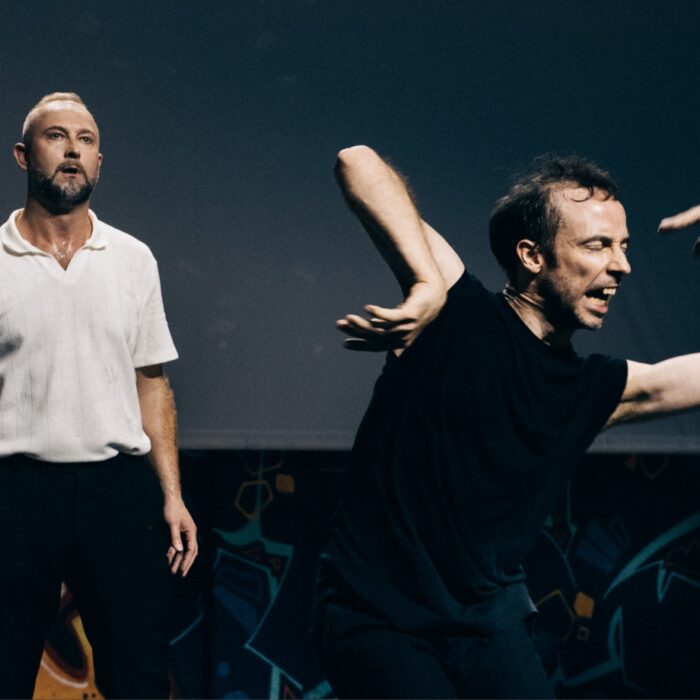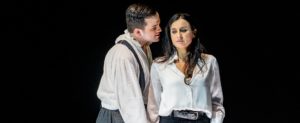
Donizetti Opera Festival 2019 Review: Lucrezia Borgia
Carmela Remigio Triumphs In The Title Role While Xabier Anduaga Cements Himself As A Promising Voice
By Francisco Salazar(Credit: Gianfranco Rota)
“Lucrezia Borgia” is perhaps one of Donizetti’s most dramatic operas with arguably some of the most unlikeable characters in the artform. However, it ranks as one of his most inventive and one of his most compelling.
The music which brings audiences a step closer to early Verdi, sees Donizetti in experimental mode with some of the traditional forms. Those who are familiar with the double arias present throughout his oeuvre may find themselves surprised when he eschews them altogether. The same goes for other scenes in which Donizetti seems to be testing the line between traditional opera language and a potential for a newer and more direct one.
You probably wouldn’t realize just how ahead of its time “Lucrezia Borgia” actually was based on more modern approaches to the work, which often becomes a showcase for the leading lady and the vocal fireworks that she can put on during the performance, with the high notes of the finale often the most hotly anticipated moments of the night.
However, at the Donizetti Opera Festival, “Lucrezia Borgia” finally got its due with a remarkable cast and conductor that relied on dramatic force and a new critical edition that is said to be Donizetti’s final intentions for the opera.
The Critical Edition
The new critical edition is a bit different from what audiences are used to listening to. According to program notes, Donizetti always wanted the Paris 1840 version to be presented as his final intentions.
While most of the opera remains the same, there are a few additions. There is a new aria for tenor at the beginning of the second act and the duet between Lucrezia and Don Alfonso has a different cabaletta which musicologists describe as a bit “more dramatic from the original.” Lucrezia also has a cabaletta in her first aria.
But perhaps the biggest change of the opera is the finale. The final cabaletta “Era Desso il figlio mio” was originally written on the insistence of prima donna Henriette Méric-Lalande and the aria became a showcase for divas, one that is even performed in concert galas today.
But Donizetti removed it later on because he believed it hurt the credibility of the finale and for this new production, the cabaletta is shortened. There is no repetition making for more immediacy. While it may sound awkward for most Bel Canto lovers, there is no doubt that it makes more sense from a dramatic standpoint. After a son dies, no one would sing a five minute cabaletta with roulades and coloratura. When Donizetti wrote the work he clearly had a point of view and in this Paris version the music has more urgency and ultimately suits the story best.
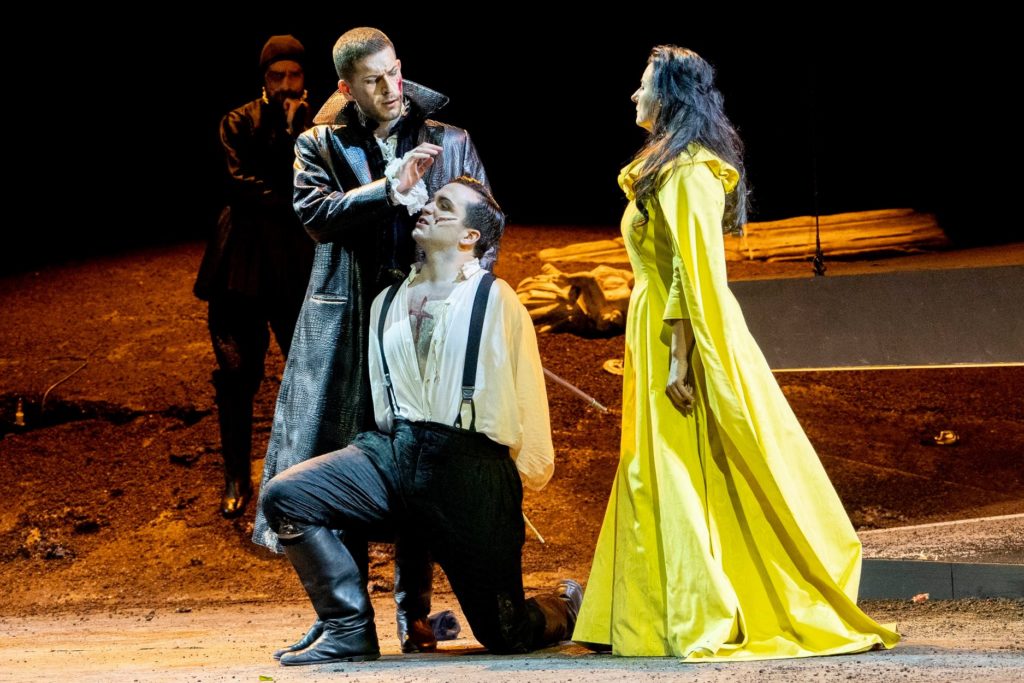
Credit: Gianfranco Rota
The Music Director
In the pit Riccardo Frizza conducted his second opera with the Donizetti Opera Festival since taking the position of Music Director. On this evening he showed why he is one of the most sought after Bel Canto conductors. His music making was always about the drama and moving the music forward. Throughout the evening the winds played with rich sound, their melodic lines emphasized the darker qualities of the music. The strings also played with rhythmic precision that gave clarity to the music.
Perhaps the most dramatic and intense moment in the evening came in the Act one finale which is made up of a duet, trio and a cabaletta. Throughout these setpieces, Frizza never stopped for a pause. Instead after each section ended, he continued the music immediately. It generated a sense of drive and dramatic tension that would have evaporated with applause in between each number. He also did not waver in his propulsive tempi throughout these passages, never slowing down to allow for extraneous vocal fireworks. Instead he accompanied the soloists very vividly, emphasizing the pizzicato in the cello line that drove the tempo forward. During Don Alfonso’s lines in the duet, Frizza placed slight accent in the violins.
Most impactful was the way he made “Era desso il figlio mio” a darker and somber piece. The emphasis on the strings and the lower chords really allowed the showstopper to feel like a true lament and less a vibrant bravura showpiece for the soprano.
A Shining Diva
Carmela Remigio returned to the Donizetti Opera Festival in the title role of “Lucrezia Borgia” and showcased herself as one of the most expressive singers performing today and one that transforms into any role that she sings. As Lucrezia Borgia it was hard to hate her but it was also hard to love her. Remigio’s Borgia was the ultimate contradiction with a number of complex facets explored throughout the opera.
The first of these was the suffering mother. At the beginning of the opera Borgia is breastfeeding a baby who is then taken away from her as she is left on stage in distress. This shift from motherly bliss to distress thus became the emotional dichotomy at the core of the story, the pendulum swinging back and forth throughout. During the prologue, Borgia disguised herself and looked upon a sleeping Gennaro full of hope. But it wouldn’t last long as her anguish returned when he awakened and disappeared. During the duet with Gennaro, she displayed the motherly delicacy she looked at Xabier Anduaga’s Gennaro with care and tenderness before filling up with remorse as she was attacked by Orsini and his entourage. Delight and joy would dominate her Lucrezia during the Act one finale as she gives Gennaro the potion that will save him from the poison, but that was counterpointed by the final duet where her pain, desperation, and suffering could not save her son. In the opera’s final moments, she slit her breast, destroying what the production had established as the symbol of her motherhood.
But the production didn’t just strive to explore Lucrezia as a suffering mother. It didn’t shy away from her perverse nature with Remigio bringing anger and lust for revenge. You could see it in her eyes as she glanced at Don Alfonso in a lustful way. Her horrid depraved manner only got worse when she entered in Act two. With imposing and commanding stage presence and a black cloak, she recited her recitative with jagged consonants and accentuations on certain words.
Finally there was a more violent side. In her complex duet with Don Alfonso, she turned a threat of rape into a moment of power for herself, throwing her rival to the floor and standing over him as if ready to murder him on the spot. On one hand, you admired her power as she freed herself from the abusive Don Alfonso. But you also feared her violent nature and brutality, noting that she was ready to match violence with even more violence. And this was only made possible by Remigio’s willingness to push herself to her physical limits in order to get to the darkest of places. There is no doubt that this was the most suspenseful and explosive moment of the entire evening.
Vocally it was also a fine night for Remigio. The soprano began with a honey-toned “Come e Bello,” singing with delicacy and lush, sustained lyrical lines. Her ensuing cabaletta “Si voli il primo a cogliere” reflected her commanding coloratura lines as she sang through each roulade with precision and clarity. During her repetition of the section, she interpolated some higher notes that were seamlessly placed within the coloratura runs.
One of the most dramatic moments came during the duet with Marko Mimica. During the first half Remigio brought a burnished tone filled with security and a manipulative spirit. That would eventually turn to desperation in the cabaletta portion “O a te bada.” During the first repeat Remigio sang with authority and drive and with a breathy sound that also added grit to her singing. The text was given precise articulation and she drove the tempo forward, almost sacrificing a bit of tonal beauty for dramatic rawness. But in the repeat that authority had been shattered and she sang with a fragile, frightened timbre. During the ensuing trio, she started to regain her power. She initially sang with short phrases in this section before unleashing a shinier timbre to save Gennaro in the Finale, “Infelice! il veleno bevesti.”
Then there was the final act. Her “Tu pur qui? was given an anguished quality that really delved into the dramatic qualities of the text, forgoing polished vocalism in favor of more complex shading. She quickly sang the lines in a staccato phrase that added more tension to the scene, emphasizing the conversational approach that Donizetti sought in the music. She went to the lower reaches of her voice in the lines “Il tuo sangue non versar,” displaying a haunted timbre filled with pain. Her “M’odi io non t’imploro” was a plea of desperation, particularity as she emphasized the words “bevi” and repeated them each time with a stroger accent.
And then there was “Era desso.” In the hands of Remigio this was a lament as she sustained each line with a rich and deep quality. The roulades were filled with pain and instead of bringing her interpolations to higher reaches, she opted for keeping them lower, creating a more haunting vocalism. It was an utterly painful and haunting manner to end one of the most tragic of all operas.
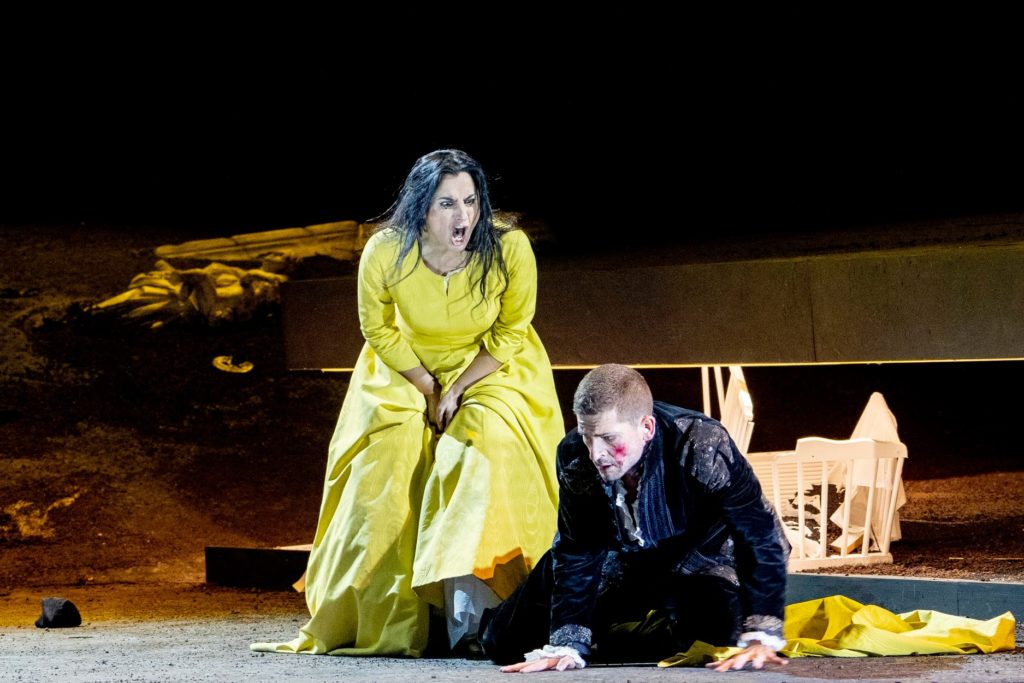
Credit: Gianfranco Rota
A Star-Making Turn
In the summer, tenor Xabier Anduaga took home the top prize at the Operalia competition, cementing himself as a star in the making. But on this night, there was no doubt that he has already arrived.
Anduaga has a bright tenor with a plush sound that can easily go from his bottom notes to glimmering high notes with evenness and ease. At the age of 24, the tenor still has Great potential and there were moments that showed that the voice is still raw. This was most evident was in his aria “Com e soave quest’ora di silenzio,” perhaps one of the most showstopping moments of the evening. Anduaga caressed each phrase with a melancholic touch and sustained bars with gorgeous color and immense sound. His ascension in his upper register was also impeccable with the high note gleaming with power and revealing a suffering in Gennaro that had not been seen to that point. His cadenza also revealed some raw emotions with the tenor imbuing the legato line with a purity of color. But there were some moments of hesitation, particularly as he attempted to crescendo a softer line, creating an unsteady effect. But ultimately his sheer expressiveness rewarded him with the evening’s biggest ovation.
Also worthy of note in Anduaga’s performance was his onstage chemistry with Remigio. In their first duet, Anduaga sang with ardor and confidence in his “Di Pescatore ignobile” and the subsequent “Ama tua made.” While Remigio brought a sadness to her phrases, Anduaga brought a brightness that lightened the duet and which saw the tenor full of passionate love for her.
Their ensuing Act one duet saw a more defiant tone as he provoked and challenged her. The tenor added more weight to his voice, imbuing it with a sense of power as Remigio attempted to give him the potion. In Act two the violence and anger of Anduaga’s Gennaro climaxed as he threw Remigio to the ground in a sexual manner before calming down upon hearing that Lucrezia is his mother. Anduaga softened the tone, singing in shortened phrases. Confusion ensued in his “sono un borgia! O! ciel” as he repeated them, trying to convince himself of his fate. Their exchange was filled with tension as the lines were sung as an argument, their voices reaching forte dynamics and the orchestra immaculately rising with the syncopation in the violins.
He sang his “madre se ognor lontano” on the floor, stretching out of the phrases with a sustained and smooth legato line, his tone filled with desperation. His “madre…io…moro” slowly faded as he decrescendoed each line into oblivion.
A Solid Supporting Cast
In the role of Don Alfonso, Marko Mimica brought a booming voice that portrayed the tyrannical figure. However, he took some time to warm up.
At the opening of “Vieni: La mia Vendetta” he sang with power and vigor and gave the text a very accented phrase. But as he continued to sing through the long vocal line, his intonation suffered and his vocal quality dried up. That was most evident in the cabaletta. Though his coloratura runs were spot on, each time he had to ascend into the higher range the intonation was off and he sounded increasingly tired.
But once he got to the duet with Lucrezia, Mimica recovered and brought imposing and lush power. He towered over Remigio’s Lucrezia as they dueled for power both in vocal fireworks and in their acting. At one point in the duet, he took Remigio’s Lucrezia and threw her to the floor attempting to rape her. In the cabaletta portion of duet, Mimica’s stacatto lines showcased a calmer and more in-control Duke who turned on Lucrezia with a cynical glance. In the trio, he brought snark and vengeful qualities as he pronounced each word in the text and sought to further his sense of control. In the trio, his “Taci” started with a whisper and then obtained a threatening aggression as he looked at Remigio with anger.
In the role of Maffio Orsini, Varduhi Abrahamyan began with unsteady tone as her voice was overpowered in the first concertato. It was in Act two where she finally shined. Her duet with Anduaga saw her voice gorgeously blend with the Spanish tenor’s. The cadenza was sung with a mezza voce sound that really emphasized the ardor these two friends or, in the case of this production, lovers felt. Her famous brindisi “Il Segreto per esser felice” was sung with allure, brightness and clear coloratura. There was a defiant nature to the song that made it all the more interesting. But on the second verse there was some hesitation with the variations in the lower half of the voice and the brightness faded into a more chiaroscuro timbre.
Other supporting characters were solidly played by Roberto Maietta, Edoardo Milletti, and Rocco Cavalluzzi. The chorus was also great as the conspirators sometimes moved from menacing whispers to rowdy and boisterous sound.
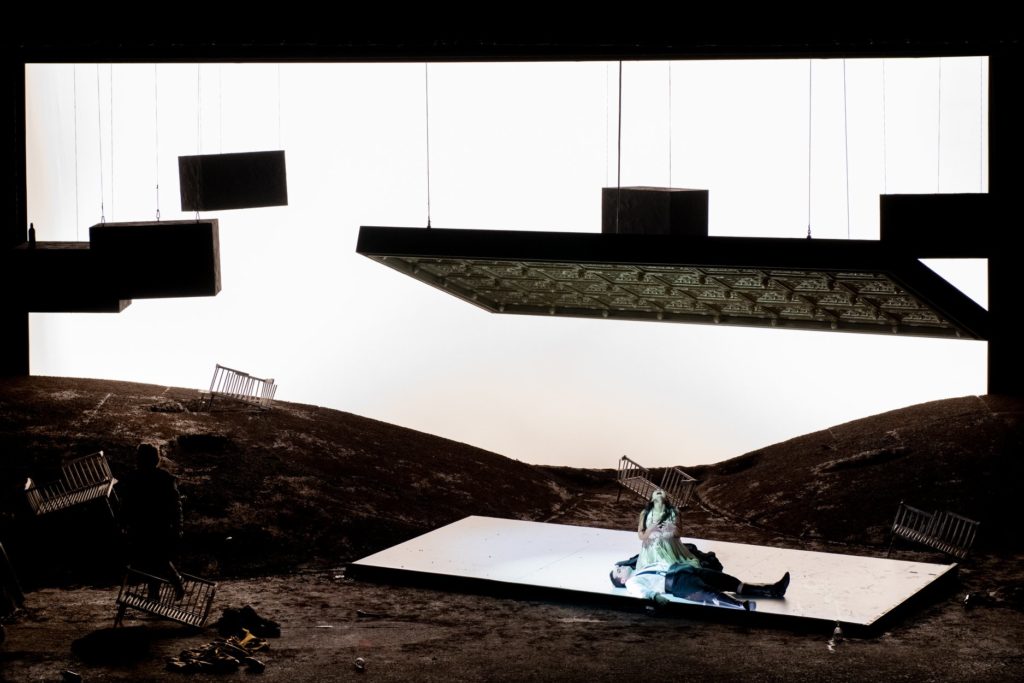
Credit: Gianfranco Rota
Minimal But Effective
Andrea Bernard directed the production, providing grittiness and realism that one rarely sees anymore. It’s hard to see a production take risks especially when it comes to showing violent actions. From the aforementioned rape attempt on Act one to Lucrezia’s blood flowing out as she cut her breast, one saw grit, depravity, and brutality that was gripping and intense at every moment.
There were also symbols such as the corpse of one Lucrezia’s victims entering the scene each time death was being foreshadowed. This corpse was seen in the prologue haunting Orsini and his entourage and then again in Act one during the trio as Gennaro was about to drink the poison. It also reappeared in the third act as Gennaro’s friends actually drank the poison. Perhaps an obvious choice for some, the sight of a body covered in blood was effective.
The set was divided into a black hill on one side filled with debris and the other side with two movable panels. One of the panels moved up and down representing different parts of Borgia’s castle. At the beginning the top one had a golden ceiling representing Lucrezia’s bedroom; at the end of the Prologue it would be knocked down to turn into the coat of arms that Gennaro disfigures. The bedroom would return at the start of Act two as Gennaro recalls a woman carrying his baby. In Act two there were also boxes that were used for exotic dancers that were lifted to reveal cribs or the five graves for Gennaro’s friends. At the end, as Lucrezia kills herself, the black curtain is lifted to reveal the white background reuniting her with Gennaro.
Lucrezia’s costumes were also quite effective. From her male disguise at the beginning to her yellow dress in Act one representing her power, they all suited the dramatic moment and character building. The black cloak she enters with in Act two was striking as she looked diabolical and consumed by vengeance. But those layers started shredding and as she took off her black cloak, the yellow dress returned as she attempted to use her power to convince Gennaro to drink her potion. And when she was unable to convince him, she undressed into a slip that showed her powerlessness.
All in all this production proved that “Lucrezia Borgia” is a masterpiece worth seeing and one that every major theater should be performing on a frequent bases. With Carmela Remigio’s commitment, Xabier Anduaga’s ardent sound, and Riccardo Frizza’s impeccable conducting, this production ranks among the best all year.


